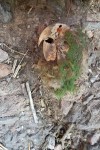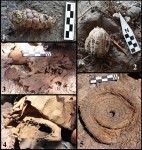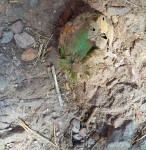 The ancient mummified head of a macaw has been found in a cave in a suburb of San Francisco de Borja, Chihuahua northern Mexico. It was discovered by the what was likely a funerary context. Manuel Rodriguez and his son were leveling the floor of a cave on his property when they came across archaeological remains and artifacts. Though they notified archaeologists of the discovery, unfortunately residents collected objects to hand over rather than leaving the context unmarred. The recovered materials include two adult skulls, several long bones, human hair, a basket, a textile, cotton string, the woven base of a vessel or basket, worked deerskin that may have been part of a bag or a loincloth, a snail and the head of the macaw.
The ancient mummified head of a macaw has been found in a cave in a suburb of San Francisco de Borja, Chihuahua northern Mexico. It was discovered by the what was likely a funerary context. Manuel Rodriguez and his son were leveling the floor of a cave on his property when they came across archaeological remains and artifacts. Though they notified archaeologists of the discovery, unfortunately residents collected objects to hand over rather than leaving the context unmarred. The recovered materials include two adult skulls, several long bones, human hair, a basket, a textile, cotton string, the woven base of a vessel or basket, worked deerskin that may have been part of a bag or a loincloth, a snail and the head of the macaw.
The textile, basketry materials and the head of the macaw are in an excellent state of preservation. The conditions inside the cave naturally mummified the bird remains, even as the human remains were skeletonized. The feathers on the macaw’s head are still bright green. According to the locals who rashly scooped up the objects, the rest of the macaw’s body was also found on the site, but they only picked up the head, leaving the body pieces behind.
 Recognizing the significance of the materials, INAH archaeologists explored the cave, hoping to recover what they could of the original context. In a strip 25 meters (82 feet) long and one meter (three feet) wide, they found evidence of a reed and mud wattle housing structure with an earth floor and a the remains of charred corn cob. The cob has been sent to the laboratory for radiocarbon dating. In another area of the strip, archaeologists found a burial: the lower half of an adult human body including pelvis and both legs tied together. It’s possible this was a secondary burial, that the body was buried somewhere else first, and later transferred to this location. Piece of coal, burned corn cobs and arrowheads were also found in this section.
Recognizing the significance of the materials, INAH archaeologists explored the cave, hoping to recover what they could of the original context. In a strip 25 meters (82 feet) long and one meter (three feet) wide, they found evidence of a reed and mud wattle housing structure with an earth floor and a the remains of charred corn cob. The cob has been sent to the laboratory for radiocarbon dating. In another area of the strip, archaeologists found a burial: the lower half of an adult human body including pelvis and both legs tied together. It’s possible this was a secondary burial, that the body was buried somewhere else first, and later transferred to this location. Piece of coal, burned corn cobs and arrowheads were also found in this section.
At the end of the excavation, archaeologists had unearthed 30 arrowheads, ears of corn, a gourd, basketry, cordage, human coprolites (mineralized feces) and many pieces of wattle from walls, one of which bears the imprint of a hand left behind when the worker was packing mud into the reeds to make the wall. The style of architecture is typical of the Early-Middle Archaic period (ca. 2500-1000 B.C.), while the arrowheads are in the style of the Middle/Late Archaic or Early Agriculture period (1000 B.C.-700 A.D.).
 The structure, arrowheads and the corn cob indicate the cave habitation predates the settlement of Paquimé, one Chihuahua’s largest and most complex prehistoric towns where the first settlements appear in the 8th century. Macaws are known to have been used in religious rituals during the Middle Period of Paquimé (1060-1340 A.D.) and fragments of macaw bones and feathers have been found there in ceremonial and funerary contexts. They were integrated into artifacts, however — bags and earrings. This is the first time an entire bird (although only the head has been recovered due to the interference with the site) has been discovered. Because the site was disturbed, archaeologists can’t say for certain that the macaw was buried along with the human remains for ritual funerary purposes, but that is the likeliest conclusion.
The structure, arrowheads and the corn cob indicate the cave habitation predates the settlement of Paquimé, one Chihuahua’s largest and most complex prehistoric towns where the first settlements appear in the 8th century. Macaws are known to have been used in religious rituals during the Middle Period of Paquimé (1060-1340 A.D.) and fragments of macaw bones and feathers have been found there in ceremonial and funerary contexts. They were integrated into artifacts, however — bags and earrings. This is the first time an entire bird (although only the head has been recovered due to the interference with the site) has been discovered. Because the site was disturbed, archaeologists can’t say for certain that the macaw was buried along with the human remains for ritual funerary purposes, but that is the likeliest conclusion.
Macaws were prized in northern Mexico and the southwestern United States. They had to be imported as they are not native to the north, so were extremely expensive. Their large size and soaring flight connected them symbolically to the sun, and their brilliant green-blue plumage was associated with lifegiving rain and water. By the Middle Period of Paquimé, macaws were being bred there for use in rituals and in commercial goods.
 The discovery of the macaw head and the snail indicate the prehistoric cultures in this part of Chihuahua had access to goods traded over significant distances. The snail is native to northwestern Sinaloa region on the Gulf of California, and the macaw had to be imported from the south. Archaeological research elsewhere in Chihuahua has found evidence of trade linking the peoples of the coast and desert north to the south via the mountains of the Sierra Madre Occidental, but this is the first evidence of it in San Francisco de Borja. In fact, it’s the first archaeological site ever registered in the municipality.
The discovery of the macaw head and the snail indicate the prehistoric cultures in this part of Chihuahua had access to goods traded over significant distances. The snail is native to northwestern Sinaloa region on the Gulf of California, and the macaw had to be imported from the south. Archaeological research elsewhere in Chihuahua has found evidence of trade linking the peoples of the coast and desert north to the south via the mountains of the Sierra Madre Occidental, but this is the first evidence of it in San Francisco de Borja. In fact, it’s the first archaeological site ever registered in the municipality.
Alice Cooper and Ozzy Ozborne could not be reached for comment.
:chicken:
“Remarkable bird, the Mexican Green, innit ? Beautiful plumage. It must be resting.”
Gosh darn those locals, messing up the site!
I wish they had pictures of the ancient poo. I got to see some coprolites in person on a recent trip to Mammoth Cave in Kentucky – I was so excited!
Very interesting, thanks!
It’s great to see stories from this part of the world now and then.